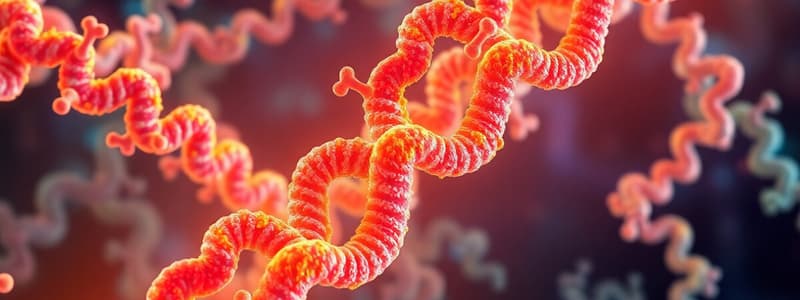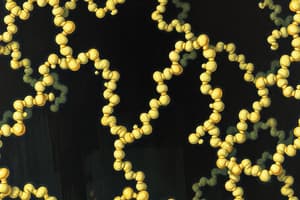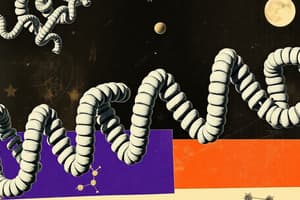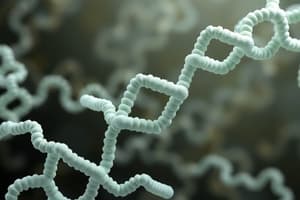Podcast
Questions and Answers
What term describes the specific three-dimensional arrangement adopted by protein molecules, setting them apart from most organic polymers?
What term describes the specific three-dimensional arrangement adopted by protein molecules, setting them apart from most organic polymers?
- Primary sequence
- Peptide conformation
- Amino acid polymer
- Native fold (correct)
How are amino acids linked together to form the primary structure of a protein?
How are amino acids linked together to form the primary structure of a protein?
- Hydrophobic interactions
- Hydrogen bonds
- Ionic interactions
- Peptide bonds (correct)
By convention, how is the primary structure of a protein read and designated?
By convention, how is the primary structure of a protein read and designated?
- In alphabetical order by amino acid name
- From the amino-terminal (N) end to the carboxyl-terminal (C) end (correct)
- From the carboxyl-terminal (C) end to the amino-terminal (N) end
- From the largest residue to the smallest
What methods are utilized to determine the amino acid sequence of a protein?
What methods are utilized to determine the amino acid sequence of a protein?
What characterizes the secondary structure of a protein?
What characterizes the secondary structure of a protein?
What stabilizes the α-helix and β-sheet structures?
What stabilizes the α-helix and β-sheet structures?
How are the side chains oriented in a stable α-helix?
How are the side chains oriented in a stable α-helix?
Which of the following amino acids is most likely to disrupt an α-helix when it occurs within the helix sequence, and why?
Which of the following amino acids is most likely to disrupt an α-helix when it occurs within the helix sequence, and why?
What characteristic of β-sheets differentiates parallel from antiparallel sheets?
What characteristic of β-sheets differentiates parallel from antiparallel sheets?
What role do proline and glycine play in β-turns?
What role do proline and glycine play in β-turns?
What is the best description of 'supersecondary structures' or 'motifs' in proteins?
What is the best description of 'supersecondary structures' or 'motifs' in proteins?
What level of protein structure is defined by the three-dimensional arrangement of all atoms in a single polypeptide chain?
What level of protein structure is defined by the three-dimensional arrangement of all atoms in a single polypeptide chain?
What interactions primarily stabilize the tertiary structure of a protein?
What interactions primarily stabilize the tertiary structure of a protein?
What is a protein domain?
What is a protein domain?
How is the disruption of a protein's native structure without breaking peptide bonds best described?
How is the disruption of a protein's native structure without breaking peptide bonds best described?
What factors can cause a protein to denature?
What factors can cause a protein to denature?
What role do molecular chaperones play in protein folding?
What role do molecular chaperones play in protein folding?
What level of protein structure involves the arrangement of multiple polypeptide chains to form a protein complex?
What level of protein structure involves the arrangement of multiple polypeptide chains to form a protein complex?
What type of interactions hold subunits together in quaternary structures?
What type of interactions hold subunits together in quaternary structures?
What can result from misfolded proteins accumulating in tissues?
What can result from misfolded proteins accumulating in tissues?
Which disease is associated with the formation of amyloid plaques due to protein misfolding?
Which disease is associated with the formation of amyloid plaques due to protein misfolding?
What is the purpose of Hydrolysis in the determination of amino acid composition?
What is the purpose of Hydrolysis in the determination of amino acid composition?
What component of the peptide structures dictates the rotation around N-C and C-C bonds?
What component of the peptide structures dictates the rotation around N-C and C-C bonds?
What is the outcome of proteins in ideal conditions recovering form denaturation?
What is the outcome of proteins in ideal conditions recovering form denaturation?
In what environment can Amino acids non-polar side chains thrive?
In what environment can Amino acids non-polar side chains thrive?
Which disease is known for the accumulation of protein in tissues?
Which disease is known for the accumulation of protein in tissues?
Which of the following is a characteristic of peptide bonds in proteins?
Which of the following is a characteristic of peptide bonds in proteins?
What is Edman degradation used for?
What is Edman degradation used for?
What is generally true of the nonrepetitive secondary structures?
What is generally true of the nonrepetitive secondary structures?
What function do supersecondary structures serve?
What function do supersecondary structures serve?
What classifies the known structure of a protein?
What classifies the known structure of a protein?
What is true about globular proteins regarding secondary structural elements?
What is true about globular proteins regarding secondary structural elements?
What is the configuration of Amino acid in proteins?
What is the configuration of Amino acid in proteins?
How is protein tertiary structure analyzed?
How is protein tertiary structure analyzed?
What is a proteins native fold?
What is a proteins native fold?
What is the role of protein misfolding?
What is the role of protein misfolding?
What holds polypeptide helices together?
What holds polypeptide helices together?
What contributes to helix stability?
What contributes to helix stability?
What is true regarding the relationship between globular proteins and chains?
What is true regarding the relationship between globular proteins and chains?
Which amino acids stabilize beta turns?
Which amino acids stabilize beta turns?
How do nonrepetitive secondary structures primarily contribute to a globular protein's overall architecture?
How do nonrepetitive secondary structures primarily contribute to a globular protein's overall architecture?
Which of the following interactions is most crucial for stabilizing the quaternary structure of a protein with multiple subunits?
Which of the following interactions is most crucial for stabilizing the quaternary structure of a protein with multiple subunits?
What is the primary role of 'molecular chaperones' in the context of protein folding?
What is the primary role of 'molecular chaperones' in the context of protein folding?
What is a key characteristic of the peptide bond that influences protein structure?
What is a key characteristic of the peptide bond that influences protein structure?
How does the orientation of amino acid side chains contribute to the stability of an alpha-helix?
How does the orientation of amino acid side chains contribute to the stability of an alpha-helix?
In the context of protein structure, what is the significance of domains?
In the context of protein structure, what is the significance of domains?
What is the primary consequence of protein denaturation?
What is the primary consequence of protein denaturation?
How does a single amino acid substitution in the primary structure of hemoglobin lead to sickle cell anemia?
How does a single amino acid substitution in the primary structure of hemoglobin lead to sickle cell anemia?
What role do performic acids play in the analysis of protein structure?
What role do performic acids play in the analysis of protein structure?
How are beta-turns (or beta-bends) crucial for protein structure?
How are beta-turns (or beta-bends) crucial for protein structure?
Flashcards
Native Fold
Native Fold
The specific three-dimensional arrangement of a protein molecule.
Primary Structure
Primary Structure
The linear sequence of amino acids in a polypeptide chain.
Peptide Bonds
Peptide Bonds
Covalent bonds linking amino acids in a polypeptide chain.
Alpha Helix
Alpha Helix
Signup and view all the flashcards
Beta Sheet
Beta Sheet
Signup and view all the flashcards
Secondary Structure
Secondary Structure
Signup and view all the flashcards
Random Coil
Random Coil
Signup and view all the flashcards
Secondary Structure
Secondary Structure
Signup and view all the flashcards
Super Secondary Structures (Motifs)
Super Secondary Structures (Motifs)
Signup and view all the flashcards
Tertiary Structure
Tertiary Structure
Signup and view all the flashcards
Domains
Domains
Signup and view all the flashcards
Denaturation
Denaturation
Signup and view all the flashcards
Molecular Chaperones
Molecular Chaperones
Signup and view all the flashcards
Quaternary Structure
Quaternary Structure
Signup and view all the flashcards
Misfolded Proteins
Misfolded Proteins
Signup and view all the flashcards
Primary Structure
Primary Structure
Signup and view all the flashcards
Study Notes
Committee V
- This section consists of 8 lectures and 1 lab section.
- Topics include proteins, protein structures, buffer systems, feed & fast cycle, and water.
- 10% of the total committee grade is based on lab grades.
- "Lippincott's Illustrated Reviews: Biochemistry 6th Edition" is followed in class and is available in English and Turkish in the library.
- "Experimental Biochemistry for Medical Sciences Students” (T. Yigitbasi, S.S.Erdem, P.Bozaykut) and “Lehningers Principals of Biochemistry" are required for laboratory sections.
Learning Objectives
- Understanding protein structures
- Knowing the importance of primary structure
- Learning about amino acids and interactions, contributing to secondary structure of proteins
- Knowing about Tertiary and quaternary structure of proteins
- Learning about diseases related to protein misfolding
Structure of Proteins
- 20 amino acids form proteins with varying sequences.
- Unlike other organic polymers, proteins have a specific 3D conformation.
- This structure enables specific biological functions.
- The structure that allows the protein to perform its biological function is termed the native fold.
- The native fold is stabilized by numerous favorable interactions within the protein.
Four Levels of Protein Structure
- Primary structure: amino acid sequence.
- Secondary structure: local spatial arrangement of the polypeptide backbone.
- Tertiary structure: overall three-dimensional structure of a polypeptide.
- Quaternary structure: arrangement of multiple polypeptide subunits.
Primary Structure
- Primary structure is the sequence of amino acids.
- Amino acids are linked covalently by peptide bonds.
- A component amino acid in a polypeptide is called is a "residue" or "moiety”.
- Strong acids or bases at high temperatures are required to break peptide bonds.
- By convention, a protein's primary structure starts at the amino-terminal (N) end and finishes at the carboxyl-terminal (C) end.
Effect of Primary Structure Changes
- Abnormal hemoglobin results from single amino acid substitutions.
- Single amino substitutions (changes) can cause hemoglobin to crystallize.
- Crystallization of hemoglobin leads to deformed red blood cells and blood vessel blockages.
Formation of Primary Structure
- Amino acid sequences are read from the N-terminal to the C-terminal end of the peptide.
- Each component in the sequence is called a residue.
- Peptide bonds exhibit partial double-bond characteristics.
- α-amino and α-carboxyl bonds can freely rotate.
- Carbonyl and amide amine groups are involved in hydrogen bonding.
Importance of Primary Structure
- Primary structure helps predict secondary and tertiary structures through sequence comparisons.
- Genetic diseases can arise from abnormal amino acid sequences.
- The molecular mechanism of protein action can be understood by studying primary structure.
Methods of Amino Acid Sequence Determination
- Identification and quantification of amino acids
- End group analysis (Edman degradation)
- DNA sequencing method
Determination of Amino Acid Composition
- Hydrolysis of peptide bonds
- Ion exchange chromatography
- Labeling with ninhydrin
- Analysis with spectrophotometry
Edman Method
- The N-terminal end of the protein is labeled.
- Phenyl-isothiocyanate is used to cleave the peptide bond under mild conditions.
Secondary Structures
- Secondary architecture refers to the local spatial arrangement of a polypeptide's backbone.
- α helix & β sheet are two common regular arrangements.
- α helix: stabilized by hydrogen bonds between nearby residues.
- β sheet: stabilized by hydrogen bonds between adjacent segments that may be distant.
- Irregular arrangement of the polypeptide chain is called the random coil.
Secondary Structure Details
- Localized arrangements of adjacent amino acids are formed as the polypeptide chain folds, and produce regular arrangements.
- It consists of α-helices, β-pleated sheets, β-bends (reverse turns), non-repetitive structures, and super-secondary structures (motifs).
- The amide group is rigid and planar, so rotation about the C-N bond is not feasible.
- Rotation can occur about the N-Cα and Cα-C bonds.
- A trans configuration is more stable than a cis configuration for R groups at Cα.
The α Helix
- The alpha-helix is the most common polypeptide helix in nature.
- Keratin (fibrous protein) and myoglobin (globular protein) contain alpha-helices.
- The helical backbone is held together by hydrogen bonds between the backbone amides of amino acids n and n+4.
- Peptide bonds align roughly parallel to the helical axis.
- A right-handed helix has 3.6 residues (5.4 Å) per turn.
- Side chains point outward and are roughly perpendicular to the helical axis.
- The helix's inner diameter is about 4-5 Å, which is too small for anything to fit inside.
- The helix's outer diameter is 10-12 Å.
- The outer diameter fits well into the major groove of dsDNA.
- Residues 1 and 8 align nicely on top of each other.
Sequence Affects Alpha Helix Stability
- Not all polypeptide sequences form α-helical structures.
- Small hydrophobic residues like alanine (Ala) and leucine (Leu) are strong helix formers.
- Proline (Pro) acts as a helix breaker due to the impossibility of rotation around the N-Cα bond.
- Glycine (Gly) acts as a helix breaker because the tiny R-group supports other conformations.
- Charged amino acids (glutamate, histidine, lysine) disrupt the helix structure.
- A large quantity of bulky side chain-bearing amino acids e.g. tryptophan and isoleucine can interfere with the structure.
- Attractive or repulsive interactions between side chains 3–4 amino acids apart can affect formation.
Beta Sheets
- Beta sheets are commonly formed with two or more polypeptides that are side by side.
- All peptide components participate in hydrogen bonding.
- The planarity of the peptide bond and tetrahedral geometry of the α-carbon creates a pleated sheet-like structure.
- The sheet-like backbone is held together by hydrogen bonds between the backbone amides in different strands.
- Side chains project out of the sheet, alternating in the up and down directions.
Parallel and Antiparallel Beta Sheets
- Parallel or antiparallel orientations of two chains within a sheet are possible.
- Parallel β sheets have strands running in the same direction with bent H-bonds (weaker).
- Antiparallel β sheets have strands running in opposite directions with linear H-bonds (stronger).
Beta Turns
- Beta turns (β-bends) occur where β sheets change direction.
- Beta turns contribute to the globular shape of proteins.
- Turns are stabilized by a hydrogen bond from a carbonyl oxygen to amide proton three residues down the sequence.
- Proline and glycine are frequently found in β turns.
- Beta turns often promote the formation of antiparallel beta sheets, and occur at protein surfaces.
- Involve four successive amino acid residues.
Non-Repetitive Structures
- A considerable a large part of a globular protein's structure may show irregular or unique features.
- They include coils and loops.
- These nonrepetitive secondary structures are not random, but have less regular structure than those of alpha-helices and beta-sheets.
Super Secondary Structures (Motifs)
- Globular proteins combine secondary structure elements such as alpha-helices, beta-sheets, and coils.
- These structural elements create geometric patterns or motifs, connected with loop regions.
- Motifs include beta-alpha-beta, Greek key, beta-meander, and beta-barrel motifs.
Tertiary Structure
- The tertiary structure is a polypeptide's three-dimensional conformation.
- Common characteristics of protein tertiary structure reveal the biological functions and evolutionary origins of proteins.
- The function of a protein requires its tertiary structure, and disrupts activity when disrupted.
Domains
- Polypeptide chains with more than 200 residues typically fold into two or more globular clusters called domains.
- Domains contribute to the functional and 3D structure of proteins.
- Domains have specific functions, such as small molecule binding.
- Domains are structurally independent units with characteristics that resemble small globular proteins.
Interactions Stabilizing Tertiary Structure
- The final shape is determined by bonding interactions between the "side chains" on the amino acids.
- These include hydrogen bonds, ionic bonds, disulphide bridges, and hydrophobic interactions.
Formation of Disulfide Bonds
- Performic acid can break down S-S bonds.
- Non-polar amino acid side chains are typically located in the interior of the polypeptide chain in a reverse arrangement within lipids.
Determination of Tertiary Structure
- Methods used to determine protein structures include:
- X-ray crystallography
- Nuclear Magnetic Resonance studies
- Atomic coordinates of most structures are deposited in the Protein Data Bank (PDB).
- Protein data banks allow comparing and analyzing varied protein structures.
Protein Folding
- Interactions of side chains determine how a protein will fold into a three dimensional structure.
- Primary structures form secondary structures which then stabilizes buy the formation of tertiary structures.
- The peptide achieves its fully folded, native (functional) form in the final stage.
Denaturation of Proteins
- When proteins denature, they unfold without hydrolyzing peptide bonds.
- Denaturation can result from heat, organic solvents, strong acids and bases, detergents, and heavy metal ions (Pb).
- Denaturation can be reversible in the right conditions, however, most proteins will not regain their structure and will precipitate.
Chaperons
- For many proteins, folding is a facilitated process that requires specialized proteins called molecular chaperones or heat shock proteins.
- Molecular chaperones interact with polypeptides at different stages of folding.
- Some chaperones bind to hydrophobic regions to prevent folding until synthesis is complete, while others form cage-like structures.
- Partially folded proteins enter the cavity of the chaperons, folds, and are subsequently released.
Quaternary Structure
- Some proteins are composed of two or more polypeptide chains (subunits).
- Quaternary structure refers to the arrangement of these polypeptide chains (subunits).
- Subunits are held together by non-covalent interactions like ionic bonds, hydrogen bonds, and hydrophobic bonds.
Protein Misfolding
- Misfolded proteins can form intracellular or extracellular aggregates, which are associated with a number of diseases.
Amyloid Disease
- Amyloid plaques are associated with the development of Alzheimer's disease.
- Amyloid Beta is an extracellular peptide containing 40-42 amino acids.
- The peptide, when aggregated in a beta-pleated sheet configuration, is toxic.
Prion Disease
- Diseases caused by prion aggregates.
Test Questions and Answers
- Which of the following are known as helix breakers?
- a) Proline and glycine
- Which of the following bonds does performic acid used to break in proteins? (TUS 2008)
- D. Disulfide bond
- A structure that has hydrogen bonds between polypeptide chains arranged side by side is a
- c) ẞ-pleated sheets
- Which of the following disease is seen as a result of accumulation of misfolded protein in tissue? (TUS 2008)
- E. Amyloidose
Studying That Suits You
Use AI to generate personalized quizzes and flashcards to suit your learning preferences.




